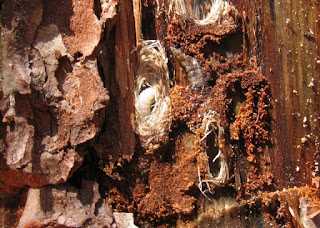Fallen pine tree damaged by pine root collar weevil.
Photo: Manfred Mielke, USDA Forest Service, Bugwood.org
Although this is more of a pest in Christmas tree plantations, every once in a while we come across pine root collar weevil damage on landscape trees.
Pine root collar weevil will attack both young and large pine trees. Host trees include Scotch pine, Austrian pine, red pine and occasionally white pine.
The larvae feed in the phloem tissue around the root collar, killing the cambium in the process. This girdling of the tree will eventually cause them to die. Pine trees weakened by root collar weevils may fall over and die one to four years after being attacked. Larvae complete development in June and July and adults emerge from July through September. After emerging, adults will feed on the trees for a short time before moving to sites to overwinter. Adult root collar weevils overwinter in the soil and in bark crevices.
It’s fairly easy to determine if your tree has been killed by pine root collar weevil. Dig around the base of the tree at the soil line. If it is root collar weevil, you will find black pitch-coated bark at the root collar and just beneath the soil. Digging around the tree you might even find yellow-white, C-shaped larvae up to a third of an inch long with an amber brown head.
Pine root collar weevil will attack both young and large pine trees. Host trees include Scotch pine, Austrian pine, red pine and occasionally white pine.
The larvae feed in the phloem tissue around the root collar, killing the cambium in the process. This girdling of the tree will eventually cause them to die. Pine trees weakened by root collar weevils may fall over and die one to four years after being attacked. Larvae complete development in June and July and adults emerge from July through September. After emerging, adults will feed on the trees for a short time before moving to sites to overwinter. Adult root collar weevils overwinter in the soil and in bark crevices.
It’s fairly easy to determine if your tree has been killed by pine root collar weevil. Dig around the base of the tree at the soil line. If it is root collar weevil, you will find black pitch-coated bark at the root collar and just beneath the soil. Digging around the tree you might even find yellow-white, C-shaped larvae up to a third of an inch long with an amber brown head.
Pine root collar weevil damage at base of small pine tree.
Photo: Steven Katovich, USDA Forest Service, Bugwood.org
If pine root collar weevil is found then you should check around the base of any other pine trees on your property. Treatments can be made to reduce or prevent root collar weevil damage to your other pine trees.
There are two periods during the growing season when pine root collar control treatments can be applied. The first is with a soil drench around the base of the tree in mid-May. The next control window will be when the majority of emerging adults are active, mid-August to the first week in September. Apply insecticide to the foliage at this time.
There are two periods during the growing season when pine root collar control treatments can be applied. The first is with a soil drench around the base of the tree in mid-May. The next control window will be when the majority of emerging adults are active, mid-August to the first week in September. Apply insecticide to the foliage at this time.
Pine root collar weevil (pupal life stage) in its feeding tunnel.
Photo: Joseph OBrien, USDA Forest Service, Bugwood.org


